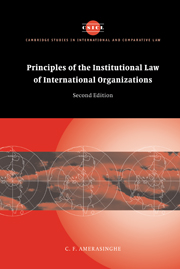Book contents
- Frontmatter
- Contents
- Preface
- List of abbreviations
- Table of cases
- 1 Introduction
- 2 Interpretation of texts
- 3 Legal personality
- 4 Membership and representation
- 5 Non-Judicial organs of organizations
- 6 Acts of non-judicial organs: their legal effect
- 7 Acts of non-judicial organs: the doctrine of ultra vires
- 8 Judicial organs
- 9 The internal law: employment relations
- 10 Privileges and immunities
- 11 Financing
- 12 Responsibility to and of international organizations
- 13 The liability of member states vis-à-vis third parties
- 14 Amendment of constitutions
- 15 Dissolution and succession
- 16 The settlement of disputes
- Index
- Cambridge Studies in International and Comparative Law
4 - Membership and representation
Published online by Cambridge University Press: 10 December 2009
- Frontmatter
- Contents
- Preface
- List of abbreviations
- Table of cases
- 1 Introduction
- 2 Interpretation of texts
- 3 Legal personality
- 4 Membership and representation
- 5 Non-Judicial organs of organizations
- 6 Acts of non-judicial organs: their legal effect
- 7 Acts of non-judicial organs: the doctrine of ultra vires
- 8 Judicial organs
- 9 The internal law: employment relations
- 10 Privileges and immunities
- 11 Financing
- 12 Responsibility to and of international organizations
- 13 The liability of member states vis-à-vis third parties
- 14 Amendment of constitutions
- 15 Dissolution and succession
- 16 The settlement of disputes
- Index
- Cambridge Studies in International and Comparative Law
Summary
Matters concerning membership depend primarily on the provisions of the constitutions of international organizations and on the practice of each organization. Whether the area concerned is admission to membership, suspension from privileges, termination of membership or the related issue of representation of members, it is not easy to identify general principles relevant to the interpretation of all constituent documents. On the other hand, there may be consistent practices across many organizations in implementing provisions of constitutions that could be usefully studied.
Membership
Admission to membership
In some organizations, such as the UN and most of its specialized agencies, membership is ‘universal’ in the sense that (a) the organization is open or has ‘universal vocation’ and (b) most, though not quite all, states and state-like entities are members. In others, such as the regional organizations, political and technical – the OAS, the OAU, the ADB, the EU, the IDB, the Council of Europe and the Arab League, for example – membership is limited in various ways. Generally, whether membership is ‘universal’ or limited, the original signatories who formulated the constitution become members automatically, without the need for admission, upon signature and ratification of the constitution. But thereafter states eligible must generally be admitted by decision of one or more organs of the organization even in universal (or open) organizations. This applies also to original members who ceased to be members of the organization and want to become members once again.
- Type
- Chapter
- Information
- Publisher: Cambridge University PressPrint publication year: 2005



